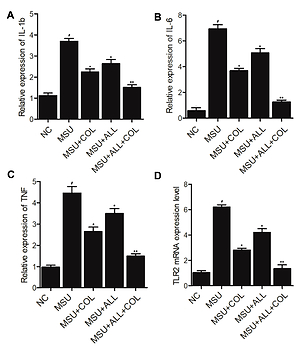Current issue
Archive
Manuscripts accepted
About the Journal
Editorial office
Editorial board
Section Editors
Abstracting and indexing
Subscription
Contact
Ethical standards and procedures
Most read articles
Instructions for authors
Article Processing Charge (APC)
Regulations of paying article processing charge (APC)
NEPHROLOGY / RESEARCH PAPER
Co-administration of Colchicine and Allopurinol alleviates vascular calcification induced by hyperuricemia via suppressing inflammation and oxidative stress
1
The Affiliated Hospital of Qingdao University, Qingdao, China
2
Pharmacy Department, The Affiliated Hospital of Qingdao University, Qingdao, Shandong Province, China, 266005, China
3
The West Coast New Area People’s Hospital of Qingdao, Qingdao, China
Submission date: 2020-06-14
Final revision date: 2020-08-17
Acceptance date: 2020-08-31
Online publication date: 2021-05-03
Corresponding author
Libo Sun
Pharmacy Department, The Affiliated Hospital of Qingdao University, Qingdao, Shandong Province, China, 266005, 16 Jiangsu Rd, Qingdao, Shandong Province, China 2, 266005, Qingdao, China
Pharmacy Department, The Affiliated Hospital of Qingdao University, Qingdao, Shandong Province, China, 266005, 16 Jiangsu Rd, Qingdao, Shandong Province, China 2, 266005, Qingdao, China
KEYWORDS
goutinflammationOxidative stresscolchicinevascular smooth muscle cellsallopurinolvascular calcification
TOPICS
ABSTRACT
Introduction:
Oxidative stress and inflammation are involved in the pathogenesis of VC in patients with hyperuricemia, while lowering the uric acid level accordingly reduces the risk of VC. Additionally, both ALL and COL suppress inflammatory response and oxidative stress. However, it is unclear whether novel therapeutic strategies, such as combined administration of COL and ALL, can achieve a better performance in lowering hyperuricemia. Therefore, we aimed to investigate the effect of co-administration of COL and ALL in the treatment of VC.
Material and methods:
Von Kossa staining was performed to evaluate the aortic vascular calcification in HUC rats treated under different therapeutic conditions. Quantitative real-time PCR was carried out to analyze the expression of genes involved in the pathogenesis of hyperuricemia.
Results:
Combined administration of COL and ALL alleviated the aortic vascular calcification in HUC rats. The aberrant up-regulation of genes related to differentiation, BMP2, RUNX2, OC and ALP, was effectively reversed by the combined treatment of COL and ALL in HUC rats and cellular models. Besides, the dysregulation of enzymes and cytokines involved in oxidative and inflammatory responses was restored by the combined treatment of COL and ALL.
Conclusions:
In this study, we tested the therapeutic effect of ALL combined with COL on the treatment of VC in animals with hyperuricemia by examining their influence on oxidative stress and inflammation. Our work helped to gain a deeper insight into the molecular mechanism of hyperuricemia, and revealed that the efficiency of the combined treatment with COL and ALL out-performed the mono-therapy of any single compound.
Oxidative stress and inflammation are involved in the pathogenesis of VC in patients with hyperuricemia, while lowering the uric acid level accordingly reduces the risk of VC. Additionally, both ALL and COL suppress inflammatory response and oxidative stress. However, it is unclear whether novel therapeutic strategies, such as combined administration of COL and ALL, can achieve a better performance in lowering hyperuricemia. Therefore, we aimed to investigate the effect of co-administration of COL and ALL in the treatment of VC.
Material and methods:
Von Kossa staining was performed to evaluate the aortic vascular calcification in HUC rats treated under different therapeutic conditions. Quantitative real-time PCR was carried out to analyze the expression of genes involved in the pathogenesis of hyperuricemia.
Results:
Combined administration of COL and ALL alleviated the aortic vascular calcification in HUC rats. The aberrant up-regulation of genes related to differentiation, BMP2, RUNX2, OC and ALP, was effectively reversed by the combined treatment of COL and ALL in HUC rats and cellular models. Besides, the dysregulation of enzymes and cytokines involved in oxidative and inflammatory responses was restored by the combined treatment of COL and ALL.
Conclusions:
In this study, we tested the therapeutic effect of ALL combined with COL on the treatment of VC in animals with hyperuricemia by examining their influence on oxidative stress and inflammation. Our work helped to gain a deeper insight into the molecular mechanism of hyperuricemia, and revealed that the efficiency of the combined treatment with COL and ALL out-performed the mono-therapy of any single compound.
Share
RELATED ARTICLE
We process personal data collected when visiting the website. The function of obtaining information about users and their behavior is carried out by voluntarily entered information in forms and saving cookies in end devices. Data, including cookies, are used to provide services, improve the user experience and to analyze the traffic in accordance with the Privacy policy. Data are also collected and processed by Google Analytics tool (more).
You can change cookies settings in your browser. Restricted use of cookies in the browser configuration may affect some functionalities of the website.
You can change cookies settings in your browser. Restricted use of cookies in the browser configuration may affect some functionalities of the website.



